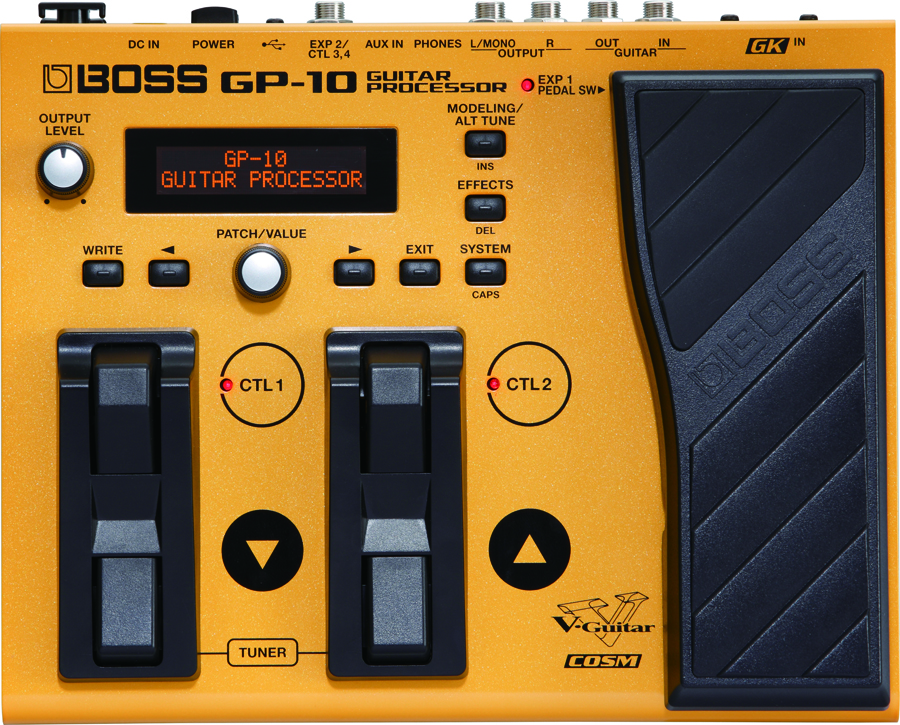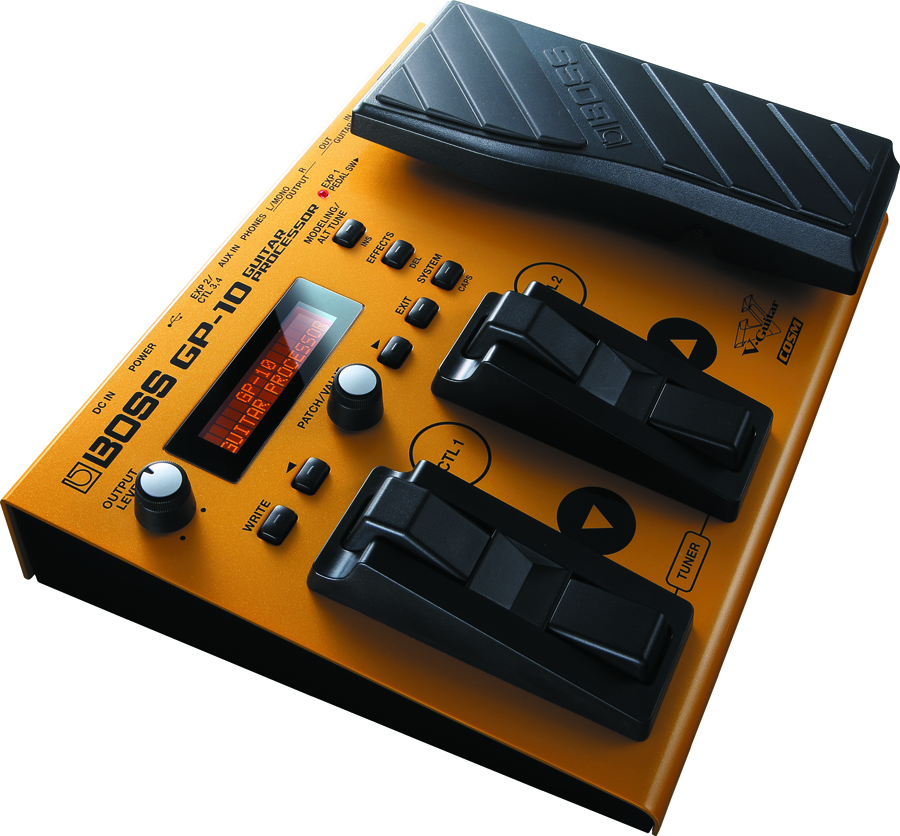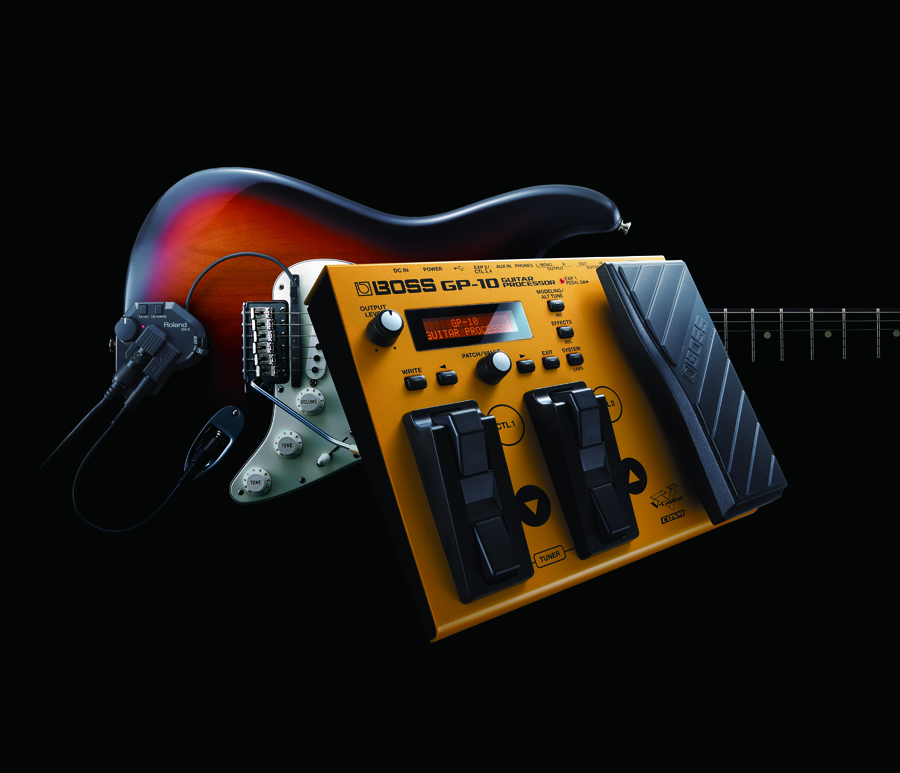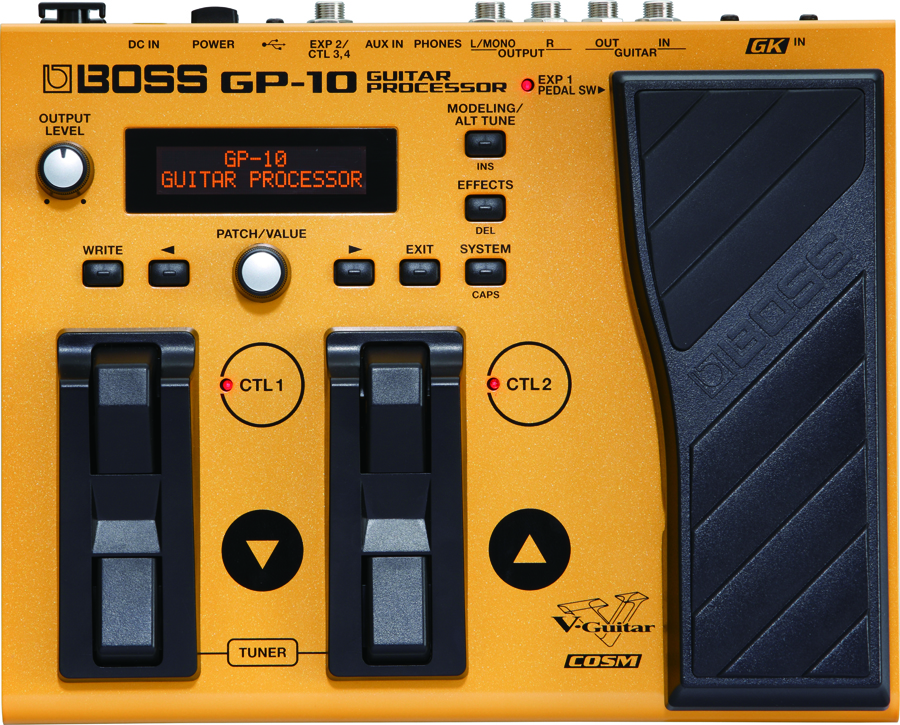Review: Boss GP-10 Guitar Processor

A certain school of guitarists have adopted the mantra “WWJD,” which, of course, means “What Would Jimi Dig?”
I have no doubt that if Hendrix were still alive and jamming, he’d be all over the Boss GP-10 Guitar Processor for its powerful combination of traditional tones, synth textures and stringed instrument emulations as well as for its instant access to alternate tunings and numerous other features.
The COSM V-Guitar technology behind the Boss GP-10 has been around for a while now (since 1995, to be exact), but the GP-10 makes that technology both more affordable and more powerful than ever.
FEATURES The Boss GP-10 is housed in a compact, road-worthy metal case that’s about two inches wider and deeper than a Boss Twin Series pedal and painted mustard yellow, perhaps in tribute to the Roland GR-100 that shook up the guitar synth market way back in 1980. It has four foot switches for controller and up/down functions, a built-in expression pedal, and seven switches for scrolling through patches, selecting effects, models or alternate tunings, and accessing system settings. The 2x16-character alpha-numeric LCD is rather modest by today’s standards, but it gets the job done (and who needs to see pictorial depictions anyway?). Boss Tone Studio software, available as a free download, makes it easy to program or edit sounds and patches using a Mac or Windows computer.
The rear panel has a standard guitar input and output, stereo 1/4-inch audio outputs, 1/8-inch headphone and aux in jacks, a 1/4-inch jack for an additional expression pedal or two control switches, USB, and a 13-pin connector for a GK pickup. The GP-10 is available with a GK-3 divided pickup that easily installs on most electric and acoustic guitars, or without the GK-3, for users who may have a GK-3, a Roland-ready guitar, or a piezo pickup, which can also drive the GP-10.
In essence, the GP-10 combines the capabilities of a multieffect processor, a guitar synthesizer and virtual guitar technology. It provides a staggering variety of electric, acoustic, bass and resonator guitar COSM models, plus banjo and sitar, COSM amp models, GR-300 analog synth tones, stunning polyphonic effects, alternate tunings, and standard guitar effects like distortion, compression, pitch shift/harmonist, phasing, flanging, chorus, rotary, delay and more. Internally the GP-10 stores 99 patches, but an unlimited number can be saved to a computer via the USB jack, which can output digital audio and MIDI.
PERFORMANCE Once you have the GK-3 pickup installed on your guitar (or if you already have a compatible pickup system), setup is easy and painless. To get the most out of the system, I recommend connecting a cable from the guitar output to your guitar amp (this passes the guitar signal through without any GP-10 processing) and connecting the standard outputs to a sound system. This allows users to blend normal guitar tones with the wide variety of textures provided by the GP-10 in full fidelity.
The GP-10’s sounds are incredible. Boss has always been at the head of the pack when it comes to effect processing, but the COSM modeled guitar and amp tones are also better than ever, and the synth and polyphonic processing effects greatly expand the guitarist’s tonal palate. The GR-300 analog synth tones can make guitar solos sound amazing, and being able to switch alternate tunings instantly greatly expands the creative possibilities of live performances. Tracking is dead-on accurate with no latency or glitchiness. Unless you’re an exceptionally sloppy player, you won’t need to change your playing style to get the best performance out of the GP-10.
CHEAT SHEET
LIST PRICES With GK-3, $699; without GK-3, $559
MANUFACTURER Boss, bossus.com
COSM V-Guitar modeling provides a huge variety of electric/acoustic/bass guitar, amp, effect, and synth tones.
The USB jack sends both digital audio and MIDI to a computer, and it also allows users to program sounds with Boss Tone Studio software.
THE BOTTOM LINE Affordable and as easy to use as a stomp box, the Boss GP-10 offers guitarists an incredible variety of new tones and textures to explore and provides instant access to effects, alternate tunings and even complete virtual guitar rigs.



Get The Pick Newsletter
All the latest guitar news, interviews, lessons, reviews, deals and more, direct to your inbox!
Chris is the co-author of Eruption - Conversations with Eddie Van Halen. He is a 40-year music industry veteran who started at Boardwalk Entertainment (Joan Jett, Night Ranger) and Roland US before becoming a guitar journalist in 1991. He has interviewed more than 600 artists, written more than 1,400 product reviews and contributed to Jeff Beck’s Beck 01: Hot Rods and Rock & Roll and Eric Clapton’s Six String Stories.
“What blew me away was that everyone wanted the curly maple top. People were calling, saying, ‘I’ve got to have the bird inlays’”: Paul Reed Smith on raising the Standard 24, finally cracking the noise-free guitar and why John Sykes is a tone hero
“It combines unique aesthetics with modern playability and impressive tone, creating a Firebird unlike any I’ve had the pleasure of playing before”: Gibson Firebird Platypus review


